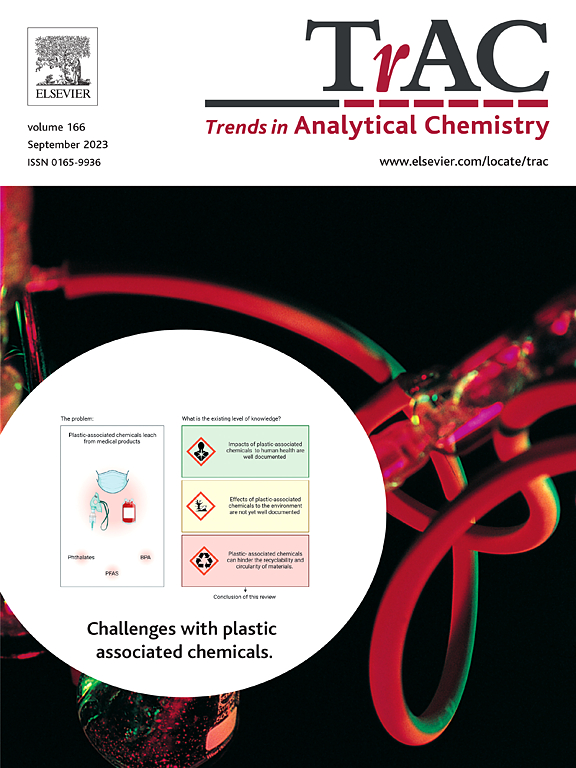Multimodal probes for the detection of bone cancer-related disease in biological systems: Recent advances and future prospects
IF 11.8
1区 化学
Q1 CHEMISTRY, ANALYTICAL
引用次数: 0
Abstract
Bone cancer can be broadly categorized into primary bone cancer and metastatic bone cancer. Primary bone cancer, such as osteosarcoma and Ewing's sarcoma, is not only highly malignant but also tends to occur in younger age groups. Metastatic bone cancer typically originates from highly malignant diseases like prostate cancer, breast cancer, and lung cancer. The presence of bone metastasis usually indicates a poor prognosis. Therefore, early detection and treatment of bone lesions are crucial for improving patient prognosis and quality of life. Commonly used conventional detection methods, such as bone imaging, computed tomography (CT), and magnetic resonance imaging (MRI), suffer from limitations in resolution or penetration depth. As a result, the detection rate for small early bone metastases is often poor. Positron emission tomography (PET) and single-photon emission computed tomography (SPECT) utilize radionuclide-labeled imaging agents to perform functional imaging. These techniques improve the specificity of detection and provide information about tissue metabolism based on the concentration of different components in various tissues. However, PET and SPECT are susceptible to interference from factors like infection and necrosis, which may lead to false-positive results. Chemical probes have largely compensated for the lack of specificity and sensitivity of conventional methods, especially Near-Infrared (NIR) and photoacoustic (PA) imaging, which not only increase the depth of detection but also do not have radiological hazards. In this review, we will discuss the importance of probes for the early detection of bone-associated cancers. Specifically, we will examine probe-associated markers, recognition modalities, and imaging modalities in the context of probes used for metastatic bone cancers originating from breast and prostate cancers, as well as for primary osteosarcoma. The use of targeted probes enables the identification of cancerous lesions in bone through binding to biomarkers expressed in cancer cells. Different probe designs allow for various recognition strategies and imaging techniques to visualize the probes after they have bound to cancer cells. Understanding current probe technologies is critical for improving early diagnosis and treatment of bone cancers.
用于检测生物系统中骨癌相关疾病的多模态探针:最新进展与未来展望
骨癌大致可分为原发性骨癌和转移性骨癌。原发性骨癌,如骨肉瘤和尤文氏肉瘤,不仅恶性程度高,而且多发于年轻群体。转移性骨癌通常源自前列腺癌、乳腺癌和肺癌等高度恶性疾病。出现骨转移通常预示着预后不良。因此,早期发现和治疗骨病变对改善患者预后和生活质量至关重要。常用的传统检测方法,如骨成像、计算机断层扫描(CT)和磁共振成像(MRI),在分辨率或穿透深度方面存在局限性。因此,早期小骨转移瘤的检出率往往很低。正电子发射断层扫描(PET)和单光子发射计算机断层扫描(SPECT)利用放射性核素标记的成像剂进行功能成像。这些技术提高了检测的特异性,并根据不同组织中不同成分的浓度提供有关组织代谢的信息。然而,PET 和 SPECT 容易受到感染和坏死等因素的干扰,从而导致假阳性结果。化学探针在很大程度上弥补了传统方法特异性和灵敏度不足的缺陷,尤其是近红外(NIR)和光声(PA)成像,不仅增加了检测深度,而且没有放射性危害。在本综述中,我们将讨论探针对早期检测骨相关癌症的重要性。具体来说,我们将结合用于乳腺癌、前列腺癌转移性骨癌以及原发性骨肉瘤的探针,研究探针相关标记物、识别模式和成像模式。使用靶向探针可通过与癌细胞中表达的生物标记物结合来识别骨癌病灶。不同的探针设计允许采用不同的识别策略和成像技术来观察与癌细胞结合后的探针。了解当前的探针技术对于改善骨癌的早期诊断和治疗至关重要。
本文章由计算机程序翻译,如有差异,请以英文原文为准。
求助全文
约1分钟内获得全文
求助全文
来源期刊

Trends in Analytical Chemistry
化学-分析化学
CiteScore
20.00
自引率
4.60%
发文量
257
审稿时长
3.4 months
期刊介绍:
TrAC publishes succinct and critical overviews of recent advancements in analytical chemistry, designed to assist analytical chemists and other users of analytical techniques. These reviews offer excellent, up-to-date, and timely coverage of various topics within analytical chemistry. Encompassing areas such as analytical instrumentation, biomedical analysis, biomolecular analysis, biosensors, chemical analysis, chemometrics, clinical chemistry, drug discovery, environmental analysis and monitoring, food analysis, forensic science, laboratory automation, materials science, metabolomics, pesticide-residue analysis, pharmaceutical analysis, proteomics, surface science, and water analysis and monitoring, these critical reviews provide comprehensive insights for practitioners in the field.
 求助内容:
求助内容: 应助结果提醒方式:
应助结果提醒方式:


